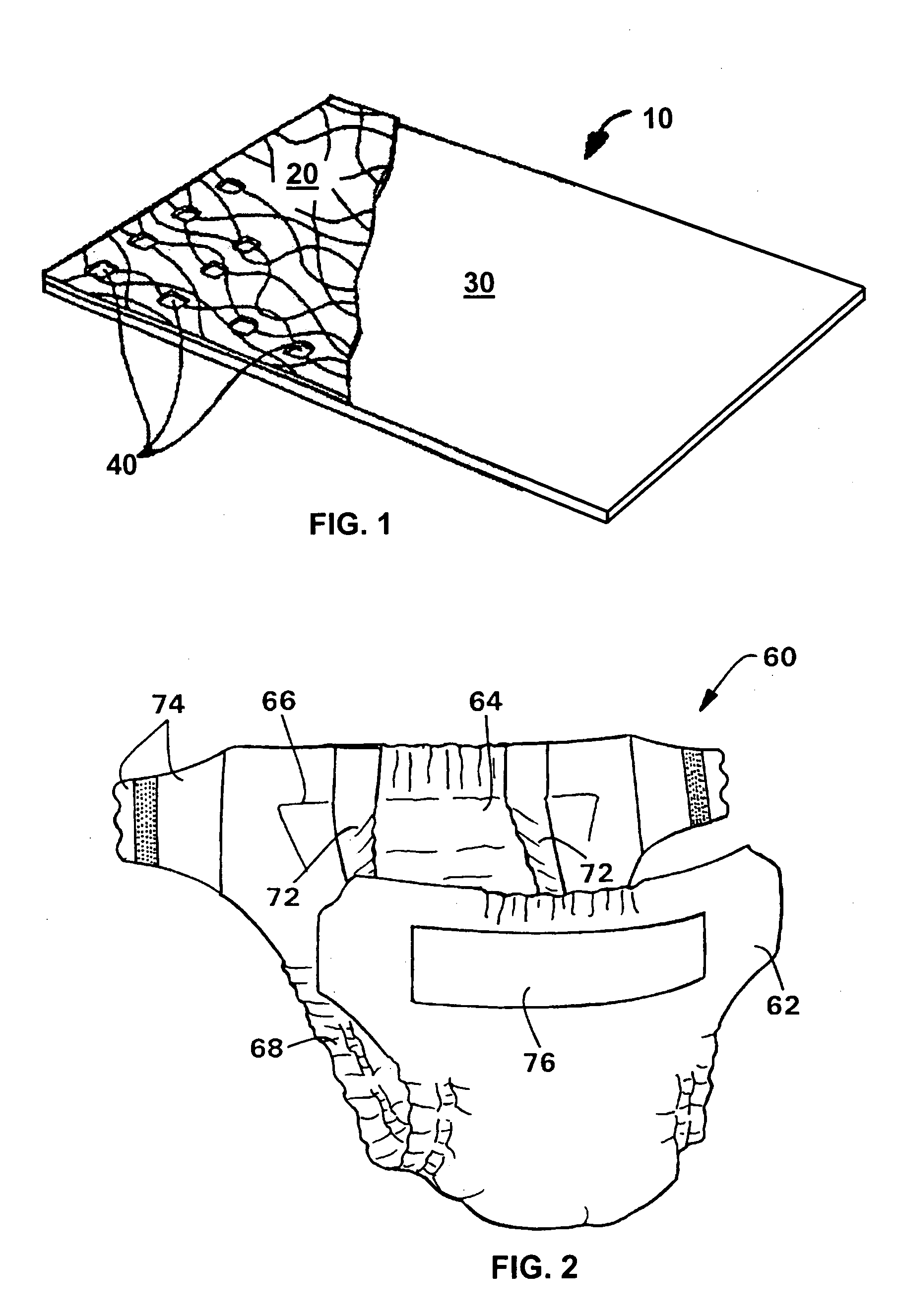Biodegradable polymer compositions for a breathable film
a biodegradable polymer and composition technology, applied in the field of compositions for manufacturing biodegradable polymer films, can solve the problems of difficult water vapor transmission rate, difficult to enhance the biodegradability of polymer films, and inability to degrade in the natural environmen
- Summary
- Abstract
- Description
- Claims
- Application Information
AI Technical Summary
Problems solved by technology
Method used
Image
Examples
example 1
[0058] Five parts of a naturally occurring polylactic acid, NATUREWORKS® 4042D from Cargill Dow Polymers LLC, may be combined with 45 parts of a copolyester, ENPOL® 8060 from Ire Chemical Ltd, and 50 parts of an inorganic filler, OMYA® 2SST calcium carbonate from Omya.
[0059] NATUREWORKS® 4042D polylactic acid has a melting point of 135 degrees Celsius, a glass transition temperature (Tg) of 52 degrees Celsius and elongation at break of 160 percent in the machine direction (MD) and 100 percent in the cross-direction (CD).
[0060] ENPOL® G8060 copolyester is a fully biodegradable aromatic / aliphatic copolyester having a melting point of 127 degrees Celsius, a melt index of 1.4-5 g / 10 min at 190 degrees Celsius and 2160 g load, and elongation at break of 250 percent (MD) and 750 percent (CD) (ASTM D638).
[0061] The typical particle diameter of OMYA® 2SST calcium carbonate is about 2 micrometers.
[0062] The mixture may then be mixed at room temperature with a blender such as a HENSCHEL® ...
example 2
[0067] The process for manufacturing the film set out in Example 1 may be repeated, with the difference being that the proportion of inorganic filler added to the mixture is 50 weight percent. The polylactic acid and copolyester, in ratios of from about 1:9 to about 9:1 weight percent with respect to each other, make up the other 50 weight percent of the mixture. Thus: [0068] (a) 10 parts of NATUREWORKS® 4042D polylactic acid from Cargill Dow Polymers are combined with 40 parts of ENPOL® 8060 copolyester from Ire Chemical Ltd and 50 parts of OMYA® 2SST calcium carbonate filler from Omya. [0069] (b) 20 parts of NATUREWORKS® 4042D polylactic acid are combined with 30 parts of ENPOL® 8060 copolyester and 50 parts of OMYA® 2SST calcium carbonate. [0070] (c) 25 parts of NATUREWORKS® 4042D polylactic acid are combined with 25 parts of ENPOL® 8060 copolyester and 50 parts of OMYA® 2SST calcium carbonate.
example 3
[0071] The process described in Example 1 may again be repeated, the difference being that the inorganic filler is added to the mixture so that it forms 55 percent of the mixture. The polylactic acid and copolyester, in ratios of from about 1:9 to about 9:1 weight percent with respect to each other, make up the other 45 weight percent of the mixture. Thus: [0072] (a) 5 parts of a naturally-derived polylactic acid, NATUREWORKS® 4042D from Cargill Dow Polymers LLC, are combined with 40 parts of a copolyester, ENPOL® 8060 from Ire Chemical Ltd, and 55 parts of an inorganic filler, OMYA® 2SST calcium carbonate from Omya. [0073] (b) 10 parts of NATUREWORKS® 4042D polylactic acid are combined with 35 parts of ENPOL® 8060 copolyester and 55 parts of OMYA® 2SST-calcium-carbonate. [0074] (c) 20 parts of NATUREWORKS® 4042D polylactic acid are combined with 25 parts of ENPOL®8060 copolyester and 55 parts of OMYA® 2SST calcium carbonate.
PUM
| Property | Measurement | Unit |
|---|---|---|
| weight percent | aaaaa | aaaaa |
| weight percent | aaaaa | aaaaa |
| weight percent | aaaaa | aaaaa |
Abstract
Description
Claims
Application Information
 Login to View More
Login to View More - R&D
- Intellectual Property
- Life Sciences
- Materials
- Tech Scout
- Unparalleled Data Quality
- Higher Quality Content
- 60% Fewer Hallucinations
Browse by: Latest US Patents, China's latest patents, Technical Efficacy Thesaurus, Application Domain, Technology Topic, Popular Technical Reports.
© 2025 PatSnap. All rights reserved.Legal|Privacy policy|Modern Slavery Act Transparency Statement|Sitemap|About US| Contact US: help@patsnap.com

